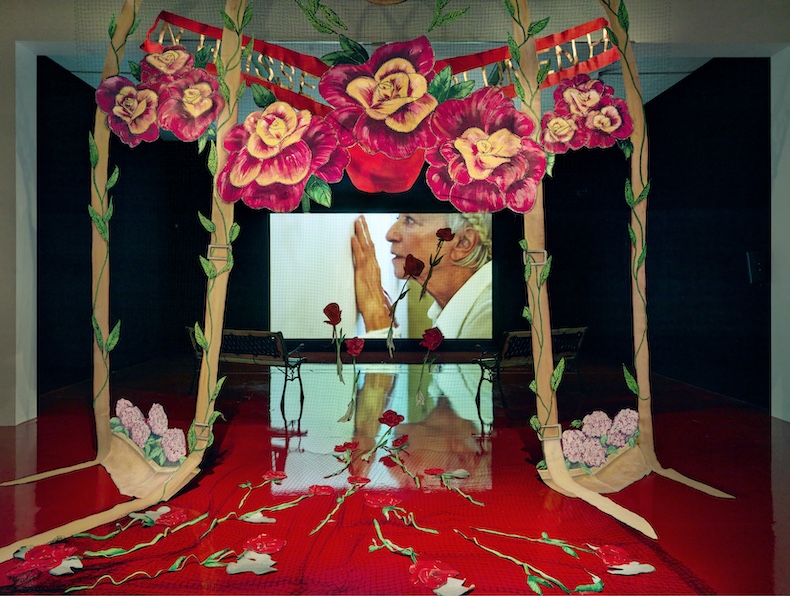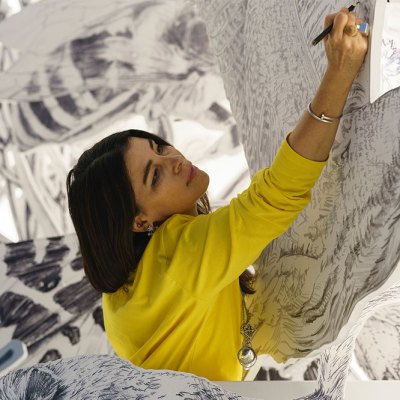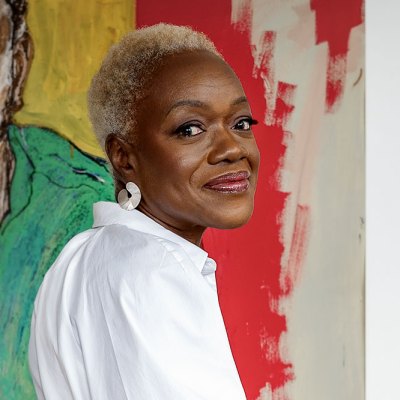For Pauline Curnier Jardin, who was born in Marseille but spends most of her time between Berlin and Rome, spectacle is everything. Her multi-disciplinary practice, which spans film, installation, performance, drawing and sculpture, is characterised by an interest in grotesque and carnivalesque aesthetics, as well as in historical, religious and mythical figures. She co-founded the all-women cabaret group Les Vraoums and helped set up the Feel Good Cooperative, a creative/activist collective made up of artists and sex workers, during the Covid lockdowns of 2020. Her films are often exhibited as part of elaborate installations: Grotta Profunda (2011), an experimental work revolving around the life of the 19th-century visionary Bernadette Soubirous, was screened at the 2017 Venice Biennale inside a grotto whose doorway was framed by a huge ogreish hand; Fat to Ashes (2021) focuses on Saint Agatha and the Cologne Carnival, and was shown at the Hamburger Bahnhof alongside a huge waxy circus tent. It is one of the films being shown at Curnier Jardin’s solo exhibition at Kiasma, Helsinki (11 October–23 February 2025), in which the artist, alongside the set designer Rachel García, has transformed the gallery into a bright, bombastic theme park.
Installation view of Grotta Profunda Approfundita by Pauline Curnier Jardin in ‘Viva Arte Viva’ at the 2017 Venice Biennale.
Photo: Daniele Zoico; courtesy Ellen de Bruijne Projects, Amsterdam/the artist; © the artist

Where is your studio?
In Rome, in a great area called San Lorenzo, near where I live. It’s a neighbourhood that was badly damaged during the Second World War, and it is also the place where one of my favourite Italian novels takes place – La Storia by Elsa Morante. It’s an anti-Fascist area. Sometimes it can be dodgy, but I love walking there. It was unfortunately gentrified in the 2000s, and now we’re seeing a second wave of gentrification, which I am probably participating in.
How would you describe the atmosphere in your studio?
It’s extremely bright. The street itself is a dead-end, so it’s used mostly as a parking spot, and sometimes people loiter around there. I have a big window that faces the street, which I love, because I can watch people pass by. It’s almost like I’m part of the street itself.
Installation view of Fat to Ashes by Pauline Curnier Jardin at the Hamburger Bahnhof, Berlin, in 2021. Photo: Mathias Voelzke; © Staatliche Museen zu Berlin, Nationalgalerie/the artist; © VG Bild-Kunst, Bonn 2021

What is your studio routine?
I have a studio manager, and we spend a lot of time in my studio together. I don’t really have a routine, except being with her and talking about our plans, so she brings the sense of routine – otherwise I would just be lost in my unstructured way of working. I love her, but I like being on my own too – that’s when I can get immersed in my world.
What do you spend most of your time doing in your studio?
I sketch a lot, drawing lines and writing words next to them. My table is full of sketches from all my different projects, and when it’s time to put them in some kind of order, I just pick up the best sketch and decide it’s a drawing. That’s how I find the art amid the chaos.
Who is the most unusual visitor you’ve had?
I often see police around, because there are some dodgy activities going on in the area. I find it interesting, because I’m obsessed with the representation of order: I’ve made a lot of works involving police and military uniforms. Once a policeman came and knocked on my door and asked me about something one of my neighbours had been doing, which I knew nothing about. He asked me what I was doing, and I told him this was an artist’s studio. He said: ‘Oh, so you’re making art?’ And I said ‘yes’, and he said ‘okay’, and then just left. It was probably the best reply I’ve ever had, because I found it funny that he didn’t ask the usual questions about whether I was painting or drawing or making films and so on. He just wanted confirmation that art was really what I was making.
Installation view of Fat to Ashes by Pauline Curnier Jardin at the Hamburger Bahnhof, Berlin, in 2021. Photo: Mathias Voelzke; © Staatliche Museen zu Berlin, Nationalgalerie/the artist; © VG Bild-Kunst, Bonn 2021

Do you listen to anything while you work?
Yes. If I’m doing something mechanical, I often listen to the radio. If I’m concentrating, then I’ll listen to music, but what I listen to changes depending on what I’m making, and changes with whatever thing I’m interested in at that time. Sometimes I listen to the music of people I want to collaborate with on a film, for instance. Otherwise I often listen to jazz. I love jazz, because I don’t know anything about it.
What is the most unusual object in your studio?
I have an antique manhole cover made from travertine, which is a stone that has been used since the Renaissance. But I also have the frame that comes with it – the square piece of pavement that the cover slots into. I found it outside my studio one day. It weighs 80 kilos, so I had to ask friends to help me carry it in. It’s like a beautiful readymade. I think of it as a door – one that gives me direct access to the past, to the underground, to hell.
Installation view of Hot Flowers, Warm Fingers by Pauline Curnier Jardin at the Centraal Museum, Utrecht in 2023. Photo: Gert Jan van Rooij; courtesy Ellen de Bruijne Projects, Amsterdam/Centraal Museum, Utrecht/ChertLüdde, Berlin/the artist; © the artist

As told to Michael Delgado.
‘Pauline Curnier Jardin’ is at Kiasma, Helsinki, from 11 October–23 February 2025.



